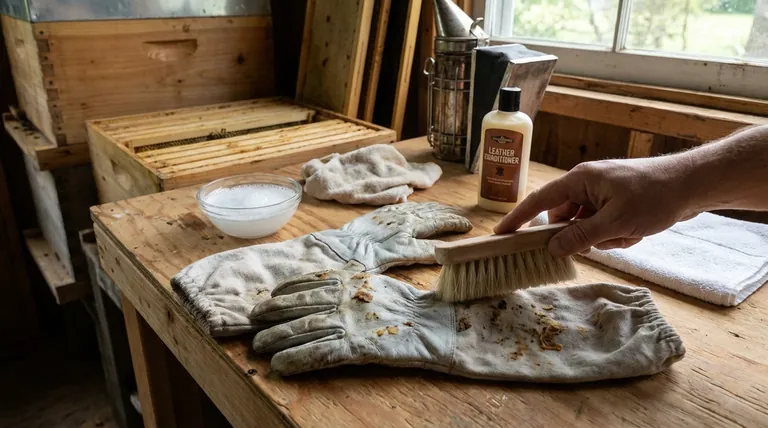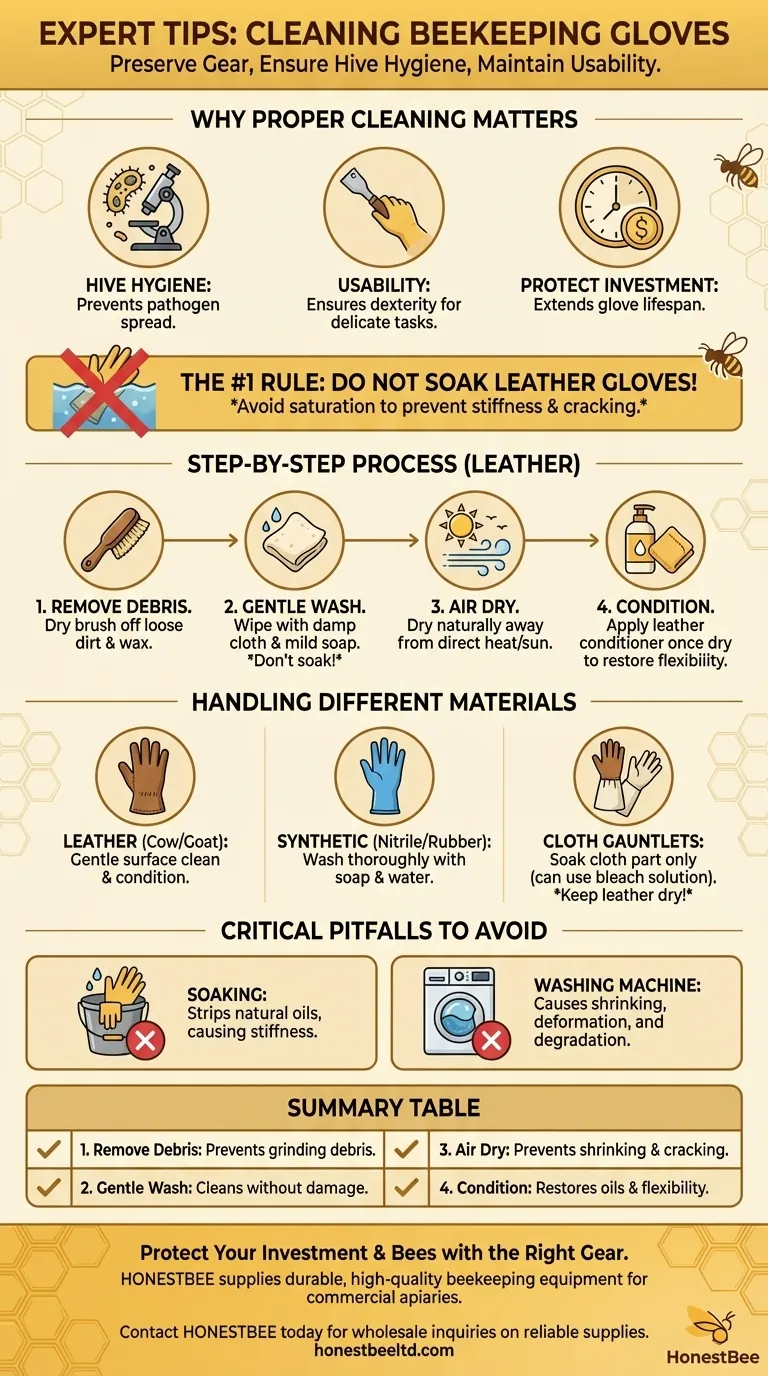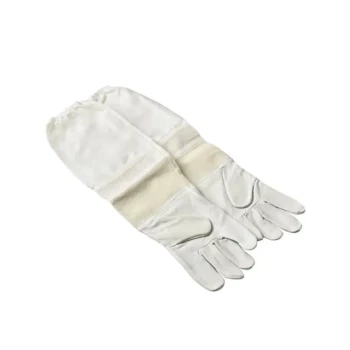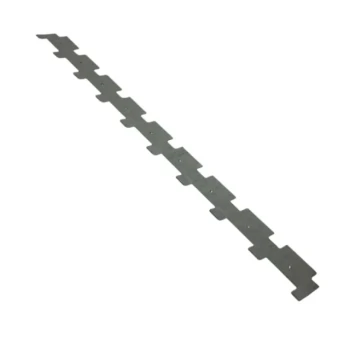To properly clean beekeeping gloves, the expert consensus is to avoid soaking them, especially if they are made of leather. The correct method involves brushing off loose debris, gently cleaning the surface with a mild soap solution and a soft cloth, and allowing them to air dry completely before applying a leather conditioner to maintain flexibility.
The primary goal of cleaning beekeeping gloves is not to make them look new, but to maintain hive hygiene and preserve the material's integrity. The key is to clean gently, avoid saturation, and properly condition the leather to prevent it from becoming stiff and unusable.

Why Proper Glove Cleaning is Non-Negotiable
Before detailing the method, it's crucial to understand why this task is so important. Proper cleaning goes beyond simple aesthetics; it's a core part of responsible apiary management.
Maintaining Hive Hygiene
Your gloves come into direct contact with multiple hives. Dirty gloves can transfer propolis, wax, and, more importantly, microscopic pathogens like bacteria and viral spores from one colony to another, potentially spreading disease.
Ensuring Usability and Dexterity
Gloves caked in crystallized honey and hardened propolis become stiff and sticky. This makes delicate tasks, like handling a queen or inspecting frames, difficult and frustrating, increasing the risk of harming your bees.
Protecting Your Investment
Good quality beekeeping gloves, particularly those made of goat or cow leather, are an investment. Regular, correct cleaning and conditioning prevent the leather from drying out, cracking, and degrading, significantly extending their lifespan.
The Step-by-Step Process for Leather Gloves
Leather is the most common material for protective beekeeping gloves, and it requires a specific care regimen. Follow these steps precisely to avoid damaging the material.
Step 1: Remove Surface Debris
Before introducing any moisture, use a dry, soft brush to remove all loose dirt, wax flakes, and other debris from the surface. Pay close attention to the seams and crevices where propolis can accumulate.
Step 2: Gentle Surface Washing
Prepare a cleaning solution of mild soap (like a saddle soap or a gentle dish soap) in a bowl of warm water. Dip a soft cloth or brush into the solution, wring it out well, and gently wipe down the gloves.
The goal is to clean the surface, not to soak the leather. Work in sections, focusing on the most soiled areas.
Step 3: Treating Stubborn Stains
For tough propolis or honey stains, you can use a small amount of white vinegar or a paste of baking soda and water. Always test this on a small, inconspicuous area first to ensure it doesn't discolor the leather.
Step 4: Proper Air-Drying
Wipe off any excess moisture with a clean, dry towel. Then, allow the gloves to air dry naturally away from direct sunlight or heat sources, which can cause the leather to shrink and crack.
Step 5: Conditioning the Leather
Once the gloves are completely dry, apply a small amount of a quality leather conditioner. Work it into the gloves with a clean cloth to restore oils, maintain suppleness, and protect the material.
Handling Different Materials and Components
Not all gloves are the same. Your cleaning approach should adapt to the specific materials of your gear.
For Goatskin vs. Cowhide
The process is nearly identical, but be aware that goatskin is often thinner and absorbs oils more readily. Use leather conditioner sparingly on goatskin gloves to avoid an overly greasy feel.
For Synthetic Gloves (Nitrile/Rubber)
If you use nitrile or rubber gloves, the cleaning process is much simpler. These can be washed thoroughly with soap and water, rinsed, and air-dried without any risk of damage.
For Cloth Gauntlets
Many gloves feature long, cloth gauntlets or sleeves. This part can be cleaned more aggressively. You can soak just the cloth portion in a solution of water and a small amount of bleach (about 1/3 cup per gallon) while carefully keeping the leather parts out of the water.
Critical Pitfalls to Avoid
How you don't clean your gloves is as important as how you do. These common mistakes can ruin a perfectly good pair.
The Damage of Soaking
Submerging leather gloves in water strips them of their natural oils. As the water evaporates, it draws even more oil out, leaving the leather stiff, brittle, and prone to cracking.
Why to Skip the Washing Machine
Never put leather beekeeping gloves in a washing machine. The combination of complete saturation and the harsh physical agitation will cause them to shrink, deform, and degrade rapidly.
Making the Right Choice for Your Gear
Use this guide to determine the best cleaning strategy based on the equipment you own.
- If you have leather gloves (cowhide or goatskin): Your focus must be on gentle surface cleaning and diligent conditioning to preserve their lifespan and flexibility.
- If you have synthetic gloves (nitrile or rubber): A simple and frequent wash with soap and water is the most effective way to maintain hygiene without worrying about material damage.
- If your gloves have attached cloth gauntlets: Clean the cloth section separately and more aggressively, taking great care to protect the leather from saturation.
Properly maintained gear is the mark of a thoughtful beekeeper, enabling you to work more effectively and protect the health of your colonies.
Summary Table:
| Step | Key Action | Why It Matters |
|---|---|---|
| 1. Remove Debris | Brush off loose dirt, wax, and propolis. | Prevents grinding debris into the leather during washing. |
| 2. Gentle Wash | Wipe with a damp cloth and mild soap solution. | Cleans surface without saturating and damaging the leather. |
| 3. Air Dry | Dry naturally away from direct heat or sun. | Prevents leather from shrinking, cracking, or becoming brittle. |
| 4. Condition | Apply a quality leather conditioner once dry. | Restores oils, maintains flexibility, and extends glove lifespan. |
Protect your investment and your bees with the right gear. Properly maintained equipment is essential for effective apiary management. HONESTBEE supplies durable, high-quality beekeeping gloves and equipment to commercial apiaries and distributors. Let us help you equip your operation for success.
Contact HONESTBEE today for wholesale inquiries on reliable beekeeping supplies.
Visual Guide

Related Products
- Goat Skin Leather Bee Sting Proof Beekeeping Gloves with Canvas Sleeve
- Goatskin Leather Beekeeper Gloves with Vent Long Sleeve for Beekeeping Honey Bee Sting Proof Protection
- Mesh Ventilated 3 Layer Goatskin Beekeepers Gloves for Beekeeping
- Professional Beekeeping Suit for Kids and Girls Childrens Bee Keeper Suit
- Professional Galvanized Hive Strap with Secure Locking Buckle for Beekeeping
People Also Ask
- What should beginner beekeepers consider when choosing beekeeping gloves? Balance Protection and Dexterity for Success
- What are the steps to clean goat leather beekeeping gloves? A Guide to Extend Gear Life
- What types of gloves are most effective at preventing bee stings? Durable Goatskin & Nitrile Barriers
- What makes polyurethane foam environmentally friendly? The Surprising Benefits of a Durable, Inert Material
- What are the key features to look for in beekeeping gloves? Find the Perfect Balance of Protection & Dexterity



















